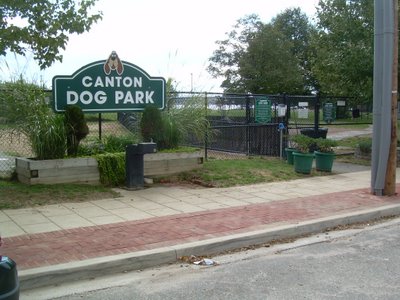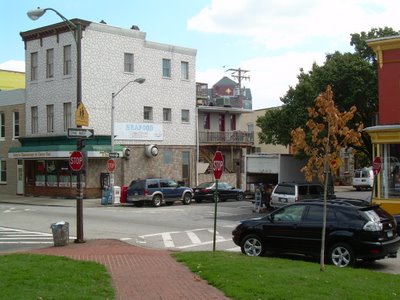Don't worry about the 50 foot Man/Woman sculpture or the dearly departed
Odorite Building. Urban landmarks come and go, and fretting about them is mostly just a source of bemusement for the powers that be.
What we should not forgive is the way the streets and transportation infrastructure around Penn Station have been abused and neglected for no good reason, resulting in a dangerous, ugly, hostile, inconvenient and desolate human environment. So without further ado...
Here are the Top Ten Transportation Abuses in the Penn Station area.

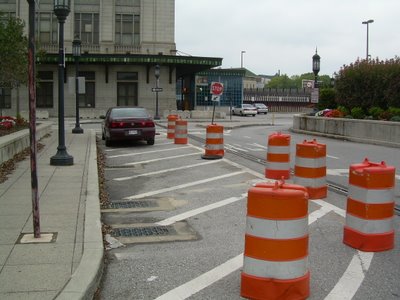
#10 - POLICE CARS UP THE CURBS AND ORANGE BARRELS ON THE DRIVEWAYS - Whatever alleged majestic grandeur the Man/Woman sculpture is supposed to evoke is pretty much nullified by the semi-permanent presence of police cars at the feet of their plaza. This seems to be standard police procedure everywhere in Baltimore. The Police apparently assume that the City revolves around their duties. It probably does, but do the rest of us have to have that fact continually ground into our senses? No pedestrian plaza or promenade seems to escape becoming the appropriated parking spaces for our city's finest.
There are almost always easy alternatives to such police parking. At Penn Station, there are parking spaces along the curbed driveways that are constantly blocked off with big orange construction barrels. Why can't the police park there? Probably because they want to be "in yo face", as if that wasn't already painfully obvious.

#9 - THE WORLD'S SHORTEST LIGHT RAIL ROUTE - After all the double tracking construction dust has settled, the
MTA has decided that the Penn Station light rail route should only run a grand total of 1000 feet as the crow flies. The photo above is from the far end of the line, only two blocks from the station. Its amazing that this decision has not led to major derision for the
MTA, but it is even more embarrassing that this was actually probably the best decision for them to make, which is why it is only ranked #9 here. It allows the
MTA to time the trains to try to serve transfers to both the north
Timonium/Hunt Valley and south
BWI-M Airport/Cromwell Station routes. It also mainly points out how useless it was to build this spur in the first place, instead of focusing on creating a decent environment around Penn Station for pedestrians to walk modest distances to and from the station. Which leads us to...
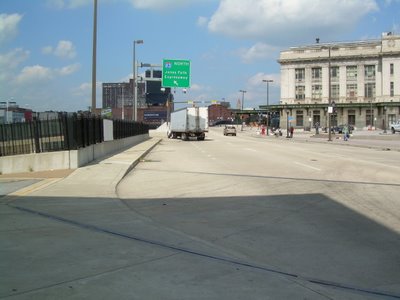
#8 - THE CHARLES/OLIVER STREET PEDESTRIAN DEATHTRAP - The most popular place for Penn Station patrons to cross Charles Street is in the vicinity of Oliver Street, shown above. The City does absolutely nothing to encourage people to cross there, making it as dangerous as possible, which will probably be a successful strategy until someone is killed. And some lawyer would probably tell them until then that this is an acceptable strategy. If you provide signals and crosswalks where some people don't want to cross Charles, such as just north of the
JFX ramp (but not for the ramp itself, see #1 below) and at Mount Royal, then you don't have to provide them where they do want to cross. The City also tries to discourage pedestrians on Oliver Street by allowing...

#7 - THE PERMANENT OLIVER STREET
JUNKPILE - Oliver Street is the only pedestrian link from Penn Station to the west, including the very significant Bolton Hill neighborhood and the Maryland Institute College of Art. But the City has conspired with the
Univeristy of Baltimore to turn the block of Oliver Street leading to Penn Station into a
junkpile. There is a permanent fenced enclosure for a dumpster just north of the street (background in the photo above), and as we all know, junk begets junk, so a second dumpster has been placed in the street bed (foreground above). The entire surrounding area is now constantly filled with various stuff and parking of various shades of legality. The "S" shaped curb shown above along the Maryland Avenue
JFX ramp, right in the middle of Oliver Street, defies any known street design criteria, and just shouts out the feeling that any sort of crap in the middle of Oliver Street will be an acceptable
accoutrement. Oliver Street should be a prime inspiration for transit-oriented development linking Penn Station with Bolton Hill, MICA, and some very key development parcels including the critical former Bolton railroad yard which is now a huge U of B parking lot and light rail station at the corner of Oliver and Mount Royal (see light rail photo above). But the state of Oliver Street makes it unlikely that potential developers, clients and users will ever be able to
envision this area's potential. In such cases, transit-oriented development becomes only hype rather than substance.
#6 - THE MARYLAND AVENUE
JFX OFF-RAMP - The ramp from the
JFX to Maryland Avenue already violated expressway design standards, but it was recently rebuilt with even tighter curves to accommodate the widening of the expressway. The way that this ramp dumps traffic into the Maryland Avenue/Oliver Street intersection also goes a long way to prevent Maryland Avenue from being the civilized urban connection necessary between Penn Station and Bolton Hill and squanders a prime parcel of land near the station. The Maryland Avenue ramp should be relocated away from Oliver, north of the Post Office fleet maintenance shop (another inappropriate land use) where it will cause no significant human harm and serve traffic much better.
#5 - NO PARKING ON CHARLES STREET - The City used the recent occasion of the painfully laborious Charles Street bridge reconstruction adjacent to Penn Station to wipe out most of the heretofore legal on-street parking that used to take place there. Why they did that is difficult to fathom. Certainly the short-term parking was important to the station, was well-used and added life to the street. It also slowed down the traffic racing to get on the
JFX and somewhat dissuaded drivers from pretending that they were already on the
JFX when they were still on Charles. But now the blocks of Charles between Mount Royal and
Lanvale stand apart from the rest of the city's venerable main street like the mini-freeway that it has become. South of Mount Royal and north of
Lanvale, parking is allowed at the left curb 24 hours a day, but it's "No Stopping Any Time" in the three blocks in between. On the right curb, parking is allowed all the time north of
Lanvale and 22 hours a day south of Oliver, but never in the blocks in between.
JFX traffic is not a factor in the right lanes, and there is little change in traffic passing
Lanvale, so what gives?

#4 - NO PARKING ON ST. PAUL STREET - Things are even stranger on St. Paul Street. Just south of the Penn Station driveway, there are permanent pylons in the right lane of St. Paul Street which guide the traffic exiting from the driveway to make a tapered merge into St. Paul Street, as if they were merging onto an Interstate Highway. The pylons also prevent an entire block of valuable on-street parking from taking place and thus deadens street activity. For a local city street, this is truly bizarre, and is done nowhere else in Baltimore (as far as I know). What is it about this area that it gets such a strange traffic treatment to accommodate a routine signalized right-turn? Again, parking is allowed along this right curb north of the Penn Station driveway, so there is no apparent reason from a traffic standpoint for preventing it to the south. It is also curious that parking is prohibited in this lane in the morning peak period to the north all the way from Charles Village to north of North Avenue, then is allowed from North Avenue to Penn Station, then is prohibited again south of Penn Station. There is no significant change in traffic volumes or patterns along this entire segment, only a change in the way the City looks at it. This forces a lot of sleepy Charles Villagers to wake up extra early just to move their cars out of the street.

#3 -
JFX OFF-RAMP TO ST. PAUL STREET - The design of this ramp is truly pathetic. It dumps exiting Jones Falls Expressway traffic directly into the St. Paul/Mount Royal intersection, but the sorriest looking pylons are used to try to force the expressway traffic to stay in the right lane of St. Paul, so that the St. Paul flow is not interrupted. This creates a mess. Traffic from both St. Paul and the ramp routinely violate this separation and also block pedestrians at the same time. This ramp was built as part of the temporary terminus of the
JFX north of downtown back in the 1960s, but as we all should know by now, many temporary things become permanent, no matter how half-
assed their original designs may be.
#2 - ST. PAUL EXPRESSWAY TRAFFIC DUMPING GROUNDS - What's even worse is that four decades ago, this
JFX ramp created a dumping ground for traffic from the expressway that should have stayed on the expressway all the way downtown. St. Paul Street in Mount Vernon has never recovered from this. The segment of the expressway between the St. Paul exit and downtown was never designed to handle all the downtown bound traffic generated by the expressway, mostly due to the delusion that the expressway would eventually be extended though Fells Point and would thus carry through traffic instead. The result is that St. Paul Street in Mount Vernon is one of the most oppressed
trafficways in the entire city. The ramp connection to St. Paul should be closed, with only its Mount Royal connection maintained, and traffic should be rerouted to other expressway exits that can better handle the load. St. Paul could then be transformed into a civilized street befitting its distinctive residential character.
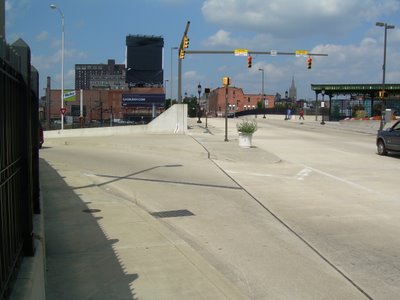
#1 - CHARLES STREET
JFX RAMP PEDESTRIAN DEATHTRAP - This ramp carries over a thousand cars in the evening peak hour alone, peeling off of Charles Street as fast as
automotively possible, directly across the sidewalk contiguous with the west side of Charles Street. And yet, believe it or not, there is not even one, single, measly, solitary trace of any sort of sign, crosswalk, signal or any other traffic control device to warn or regulate either motorists or pedestrians of the impending conflict,
assault or disaster that awaits them at this point. This is unconscionable.


